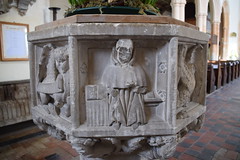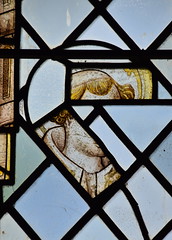| |
|
Follow these journeys as they happen at Last Of England
Twitter.
The deep south of Suffolk is one of East
Anglia's loveliest areas. The hills and valleys ripple
above the valley of the Stour, and in them hide the
county's most beautiful villages. Boxford and Kersey are
world-famous, but there are others in the area between
Sudbury and Hadleigh that are nearly as lovely but
little-known. Little Waldingfield is one such place, a
quiet, self-contained place on the Sudbury to Lavenham
road, not far from its larger neighbour. Curiously, the
churches of both villages are dedicated to St Lawrence, a
confusion, perhaps, of the 18th century antiquarians who
in the main restored the medieval dedications which had
fallen from use by reference to old documents.
The classic Suffolk parish church is one rebuilt on a
grand scale in the 15th century with aisles and a
clerestory. The biggest and best of Suffolk's churches
are like this. And so is Little Waldingfield, except that
here the rebuilding was on a smaller, more intimate
scale. On the face of it, the church bears similarities
to the great ship of St Peter and St Paul at Clare,
especially with the tall roodstair turrets at the east
end of the nave. The proportions of nave windows to
clerestory windows recall Long Melford, but the odd thing
at Little Waldingfield is that the chancel was never
rebuilt, and looks rather domestic next to the late
medieval glories of the rest of the building. Its steeply
pitched roof is tiled in red, making it look as if a
house were attached to the east end of the church. A
gorgeous, ramshackle old porch fronts the south entrance.
Around the back is the exotic surprise of a spired Tudor
red brick porch, now blocked off to form a vestry. All in
all, the building has an air of faded beauty, a building
which has quietly seen out the centuries.
You step into an interior which fulfils the promise of
the exterior delights. It is as if St Lawrence, in its
quiet backwater, was forgotten by the restorers who
scoured nearby Lavenham, Long Melford and Great
Waldingfield. Here, there is a smell of age and damp, the
old stonework of the arcades and floors a lingering
memory of the days when they were new, as is the font,
probably a bit earlier than the church around it, perhaps
contemporary with the tower in the 14th century. Four of
its panels depict monks sitting at benches and going
about their business.
 
 
Up in the roof of the south aisle, a green
man watches you carefully. Turning east, you can see that
the nave of Little Waldingfield church is a text book
example of a late medieval structure, with aisles and
clerestories on both sides, the eyes drawn upwards in the
intention of Perpendicular architecture. The quiet
simplicity of the chancel with its clear-glassed
five-light window enhances this impression. This
simplicity extends into the nave, and you feel that there
is nothing unnecessary, nothing superfluous, no clutter
to inhibit the ghosts of medieval and early modern Little
Waldingfield. This is still their church as much as ours.
You can meet some of them in the north aisle. Here are
brass figures of early 16th century Waldingfielders. They
would have seen this church when it was complete, as it
is now, albeit without the later furnishings. Robert and
Mary Appleton died in 1526. This was the year that the
artist Hans Holbein arrived in England. His portrait of
Henry VIII that year shows a grand patriarch at the
height of his powers, but also, perhaps, one can detect a
thoughtfulness, a troubled brow. The following year,
1527, Henry would apply for the annulment of his
marriage, a struggle leading ultimately to the break with
Rome and the establishment of triumphal protestantism in
England. By 1544, when the brass to John Wyncoll in his
doublet was installed, this process was already well
under way. The violence of the ensuing years means that
only tiny fragments survive of the stained glass that
once filled these windows - two quarters of a tonsured
Saint, a crowned woman, another tonsured man.
 
A reminder of happier and less turbulent
times in the parish is the grandest brass of all, the
clothier John Colman in 1506, whose family may well have
paid for the rebuilding of the church. Beneath him, his
six sons and seven daughters stand in pious grief. What
would the next half century mean to them, I wonder?
The medieval churches of England are, above all else, a
communion, a touchstone down the long generations of the
people who were born, lived and died in their parishes.
Some of them were rich and important like the Appletons,
Wyncolls and Colmans. Future generations would leave
their mark behind in the form of charity, recorded on the
benefaction boards in the north aisle, or in the
memorials around the walls. But most are lost to us, with
not even headstones in the graveyard recording their
brief lives. To stand in a church like St Lawrence is to
sense them briefly, a resonance in the air perhaps, a
movement out of sight, an echo almost heard. As the
Church of England fades from public sight, how much more
important it becomes that these buildings survive to
remind us of who we are, and where we have come from. Our
medieval churches were always more than mere worship
spaces.
Simon Knott, July 2019
Follow these journeys as they happen at Last Of England
Twitter.
|
|
|

